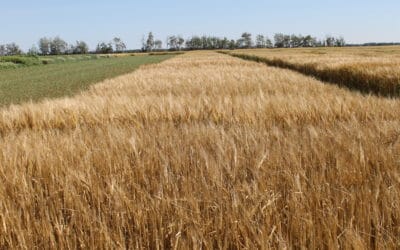The benefits of rolling a crop – either after seeding or after emergence – and tips to ensure its success.
“Rolling the crops is a great way to improve ease of harvest,” says Harry Brook, crop specialist at the Alberta Ag-Info Centre. “The biggest benefit is pushing rocks down into the earth and preventing them from causing damage to the combine or other harvest equipment.”
Brook says that in cereals used for silage, rolling allows for a maximum harvest of plant materials.
“In pulses, such as peas and lentils, it makes harvest easier as a heavy pulse crop is often lodged at harvest time. With pulses, it can lead to less ‘dirt tag’ on the seed, which is a downgrading factor for human consumption in peas.”
He adds that in some cases, producers will roll barley and get increased ‘stooling’ or secondary stem production following the rolling, which helps increase dry matter yield.
Some problems can occur if the crop is rolled at the wrong time or on wrong soil conditions and Brook says that rolling should occur with an empty roller – no water ballast is needed.
“Rolling land can pulverize the soil and break down soil aggregates, making the topsoil susceptible to wind erosion. That is a big issue. In low organic matter or fine textured soils, it can also lead to puddling and crusting of the soil surface, creating a barrier to crop emergence. This is part of the reason why a lot of crop rolling is done after emergence.”
He adds that pre-emergent rolling is not recommended under extreme wet conditions on clay soils or clay soil with low organic matter. “It is also not recommended on sandy or dry soils due to erosion risk. Peat soils will not roll well.”
Rolling an emerged crop should be done in the heat of the day when the plants are slightly wilted.
“Rolling in the morning, when plants are full of water and turgid, leads to more broken stems,” explains Brook. “It can lead to the production of more secondary stems, but it will delay crop maturity.”
“Damaged plants can also be more susceptible to disease. If there is a lot of dew on the crop and disease is present, rolling can actually help spread leaf diseases.”
He says that rolling peas should be done when the crop is at the two to three node stage. In lentils, it should be done before the seven node stage. Both crop and soil surface should be dry when rolling to reduce damage to the crop. Rolling when the soil surface is wet will lead to some plants being uprooted and killed.
To ensure rolling is successful, Brook says to delay the rolling if the crop is stressed by heat, drought, frost or a herbicide treatment.
“Rolling is stressful to an emerged crop and it will take time to recuperate from the operation. In the same vein, wait a few days either before or after herbicide application once the crop is rolled. Minimize double rolling. It is better to go around on a field rather the back and forth and double roll the headlands. Slow down when turning and avoid sharp turns as tractor tires can possibly do more damage than the rolling.”
Brooks adds that rolling cereal crops and pulses can be a very effective way to reduce the difficulties of harvesting a crop close to the ground. “However, to prevent any potential losses from the rolling, it needs to be done at the right time and in the right way. Keep rolling along.”
Source: Alberta Ag





